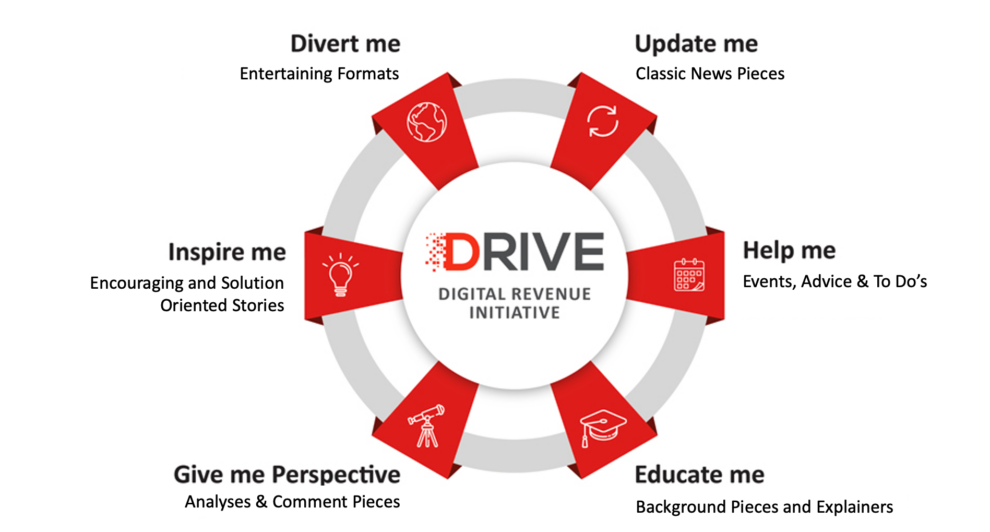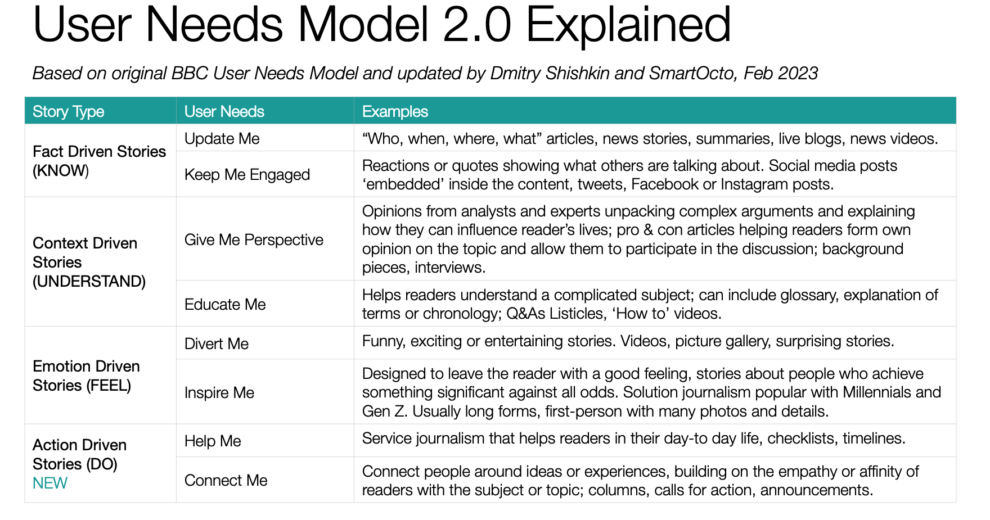Blog
The 6 Reader Cravings Explained
Back in 2016 Mediahuis and KU Leuven ran a study with our team at Twipe to identify what drives an engaging news experience. Around the same time in the UK, BBC developed their first User Needs Model, defining the 6 core reasons why people seek news stories.
The User Needs Model has seen a lot of adoption and movement in the past years which we explain in this article:
- NYT and The Athletic have moulded the model to their newsroom, adding or rephrasing some of the user needs.
- The German initiative DRIVE used an adapted version of the model to study 4000 article pieces. They recently published some of their results which we review below.
- An update to the BBC model was released earlier this year by Dmitry Shishkin and SmartOcto complementing the original 6 user needs with 2 new ones. This includes a guide on how to write articles that address specific user needs.
At Twipe we developed in 2019 the 6 Readers Cravings Model. This has its origins in the academic research project Digital Reader Engagement and was updated after further research on habit forming news products. It is also at the core of an ongoing research initiative we are working on with Roularta Media Group to define the Edition of the Future.
The 6 reader cravings – Publishers’ recipes for content completeness
What is a rewarding news reading experience? What type of content, bundled in one finite package, would leave readers satisfied, yet craving more?
From the studies on habit formation of Charles Duhigg and Nir Eyal, we know that addressing readers cravings and identifying the variable rewards are critical for building news products that fit in people’s lives and routines.

For building complete and rewarding news experiences we have identified 6 reader cravings that newsrooms have to address with the content they create:
#1 I learned Something New
- Represented in other models as “Educate Me” or “Give Me Perspective” this need is usually addressable with explainer stories that provide background on world events, political or economical context.
- Dmitry Shishkin points out that newsrooms can overestimate their audience’s knowledge on a subject, and make their stories too complicated and incomprehensible. Nic Newman addressed this topic as well as potential root cause of news avoidance.
- Audio and podcast formats that dive into specific topic are also a popular way of addressing this need.
- These pieces have the potential to become evergreens.
#2 FOMO – Being prepare to discuss with others
- Represented in other models as “Update Me” this is usually the most common type of story among news publishers.
- Research from the DRIVE project suggests these publishers tend to add often too many such stories so a good balance must be found when building digital news products.
- French publisher Ouest France creates a digital only evening edition every day at 6 PM. In the first versions of the evening edition the team had not included news stories, considering that readers would have already been updated on the news of the day. They found from readers feedback that a review of the most important news of the day was still desired, alongside a broader package of content they now add, addressing more the need for inspiration and entertainment.
#3 Information that relates to my personal life
- Stories addressing this need can be particularly predominant in regional news or can be delivered by using personalisation.
- For readers that are predominantly interested in finance, a story about a change in the local tax regime will be highly relevant to the decisions they take in their daily life. Similarly, readers expect news media to inform them about relevant changes in legislation, traffic, etc..
- Personalisation of distribution can play an important role in addressing this need. Finnish publisher Keskisuomalainen focused on delivering hyper local news via a daily personalised JAMES newsletter to make sure they can be relevant in people’s lives.
#4 Positive, Feel Good News
- The research done by the DRIVE team found that emotional stories have high engagement, but they are rarely offered by news publishers.
- Over the past years we have seen various formats emerge in this space such as the “Good news weekly roundup” selection of Euronews or the “End the day on a high note” newsletter that we launched during the JAMES Project with The Times of London.
- However, publishers can take more actions to highlight these stories in the reading experience.
#5 Humour and Entertainment
- Cartoons and entertaining stories as well as puzzles and games have always played an important role in addressing the readers need for humour and entertainment. This need should be accounted for also when building digital news products.
- Economist Espresso added a Daily Quiz to their snapshot of world events.
- L’Edition Du Soir adds new interactive games like “Spot the 7 differences” in their digital evening edition and publishers like NYT or The Guardian bet big on puzzles with separate puzzles apps.
#6 Practical Tips or “To Do” Items
- Recently added also to the User Model 2.0 developed by Dmitry Shishkin, the need for “Do Stories” is one to address in digital news products. This included coverage of local events, recipes, travel tips, etc.
- Interestingly the User Needs 2.0 Model defines a new separate need in this category, called “Connect me”. These are stories that help readers connect with their community, for example calling for volunteers for a specific community project which can drive a strong engagement with both the community and the brand.
- From the panels at recent events hosted by Twipe in NYC or FT Strategies in London we learned that this can play a powerful role especially in engaging younger generations.
Learnings from 4000 articles analysed through the User Needs model perspective
The DRIVE (Digital Revenue Initiative) Project is a consortium of 21 regional publishers in Germany with a goal of growing digital revenues through collaborative data analysis.
To understand readers needs, they analysed 4,000 randomly selected archive stories based on an adapted version of the the User Needs Model.

Adapting the model to publishers’ own needs is something we have seen also other publishers do. For example within the emotion driven pillar, The New York Times have added an ‘Enrich my life” need, whilst The Atlantic have added a “let me take a meaningful break” need as explained by Emily Gologoski.
DRIVE used 2 metrics to study the selected stories: Media Time, representing the time a reader spends on the website and Conversion Attribution Score, the likelihood of an article to contribute to a subscription being taken.
Insights extracted from their analysis can help publishers build more complete and engaging reading experiences:
- “Update me” is the leading category of stories offered. However, usage data shows that readers do not need this large amount of information.
- “Inspire me” and “Help me” articles achieve the highest engagement.
- Emotional and inspiring stories, which are popular among readers, are rarely offered.
- “Help me” contributes to a high media time, but rarely to digital subscriptions.
- Visitors who take out a digital subscription, read “Inspire me”articles above average.
- “Housing” is an important topic for regional publishers: For example Solution-oriented stories (“Inspire me”) about a challenging but successful house search or alternative housing projects are particularly popular.
- “Give me Perspective” stories contribute to a subscription being taken out.
The User Needs Model 2.0 Overview
In the User Needs 2.0 Model, needs are broken down into 4 different pillars: Fact Driven stories (Know), Context Driven Stories (Understand), Emotion Driven Stories (Feel) and the newly added in this year’s adaptation Action Driven Stories (Do). These type of stories address 8 different user needs
What stands-out is the addition of the Do Pillar with 2 new user needs: Help me and Connect me.
- “Help me” is a more personal user need. It addresses the desire to find information that helps users to solve a problem. By providing this help content details how to do something that will improve the user’s life.
- “Connect me” relates to the growing desire to be constantly engaged to the world and society around us. It addresses the desire to feel part of something bigger. This helps users to act with the wider world in mind. These new user needs reflect the progression of the demands on news publishers and the new area publishers must grow in to engage and retain their readers.

3 steps to Implement the User Needs 2.0 Model
- Select the best model fit for your newsroom based on audience research, using tools like questionnaires, surveys and polls.
- Content review: as done in the DRIVE Project, the advice of the team is to study at least 2000 pieces of content from a period of between 3-6 months assigning user needs to each piece with consistency.
- Create an improvement action plan and adapt your workflows to fit your model.
What about writing content aimed at these needs? Dmitry Shishkin has handily provided specific guidelines on how to write articles which address some of the user needs:
Other Blog Posts

Stay on top of the game
Subscribe to Twipe’s weekly newsletter to receive industry insights, case studies, and event invitations.
"(Required)" indicates required fields

